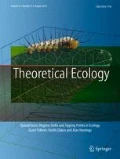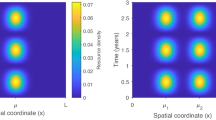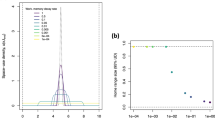Abstract
Understanding complex movement behaviors via mechanistic models is one key challenge in movement ecology. We built a theoretical simulation model using evolutionarily trained artificial neural networks (ANNs) wherein individuals evolve movement behaviors in response to resource landscapes on which they search and navigate. We distinguished among non-oriented movements in response to proximate stimuli, oriented movements utilizing perceptual cues from distant targets, and memory mechanisms that assume prior knowledge of a target’s location and then tested the relevance of these three movement behaviors in relation to size of resource patches, predictability of resource landscapes, and the occurrence of movement barriers. Individuals were more efficient in locating resources under larger patch sizes and predictable landscapes when memory was advantageous. However, memory was also frequently used in unpredictable landscapes with intermediate patch sizes to systematically search the entire spatial domain, and because of this, we suggest that memory may be important in explaining super-diffusion observed in many empirical studies. The sudden imposition of movement barriers had the greatest effect under predictable landscapes and temporarily eliminated the benefits of memory. Overall, we demonstrate how movement behaviors that are linked to certain cognitive abilities can be represented by state variables in ANNs and how, by altering these state variables, the relevance of different behaviors under different spatiotemporal resource dynamics can be tested. If adapted to fit empirical movement paths, methods described here could help reveal behavioral mechanisms of real animals and predict effects of anthropogenic landscape changes on animal movement.







Similar content being viewed by others
References
Alerstam T (2006) Conflicting evidence about long-distance animal navigation. Science 313:791–794
Armsworth PR, Roughgarden JE (2005) The impact of directed versus random movement on population dynamics and biodiversity patterns. Am Nat 165:449–465
Bailey DW, Gross J, Laca E, Rittenhouse L, Coughenour M, Swift D, Sims P (1996) Mechanisms that result in large herbivore grazing distribution patterns. J Range Manage 49:386–400
Bar-David S, Bar-David I, Cross P, Ryan S, Knechtel C, Getz W (2009) Methods for assessing movement path recursion with application to African buffalo in South Africa. Ecology 90:2467–2479
Bartumeus F (2009) Behavioral intermittence, Levy patterns, and randomness in animal movement. Oikos 118:488–494
Bartumeus FM, Da Luz G, Viswanathan G, Catalan J (2005) Animal search strategies: a quantitative random-walk analysis. Ecology 86:3078–3087
Barraquand F, Inchausti P, Bretagnolle V (2009) Cognitive abilities of a central place forager interact with prey spatial aggregation in their effect on intake rate. Anim Behav 78:505–514
Baxt W (1991) Use of an artificial neural network for the diagnosis of myocardial infarction. Ann Intern Med 115:843–848
Bell WJ (1991) Searching behaviour: the behavioural ecology of finding resources. Chapman and Hall, London
Benhamou S (1994) Spatial memory and searching efficiency. Anim Behav 47:1423–1433
Benhamou S (2007) How many animals really do the Levy walk? Ecology 88:1962–1969
Benhamou S, Bovet P (1989) How animals use their environment—a new look at kinesis. Anim Behav 38:375–383
Bennett DA, Tang W (2006) Modelling adaptive, spatially aware, and mobile agents: elk migration in Yellowstone. Int J Geogr Inf Sci 20:1039–1066
Biro D, Freeman R, Meade J, Roberts S, Guilford T (2007) Pigeons combine compass and landmark guidance in familiar route navigation. Proc Natl Acad Sci USA 104:7471–7476
Boerger L, Dalziel B, Fryxell J (2008) Are there general mechanisms of animal home range behaviour? A review and prospects for future research. Ecol Lett 11:637–650
Boone RB, Thirgood S, Hopcraft J (2006) Serengeti wildebeest migratory patterns modeled from rainfall and new vegetation growth. Ecology 87:1987–1994
Bonadonna F, Bajzak C, Benhamou S, Igloi K, Jouventin P, Lipp H, Dell’Omo G (2005) Orientation in the wandering albatross: interfering with magnetic perception does not affect orientation performance. Philos Trans R Soc B 272:489–495
Bovet P, Benhamou S (1991) Optimal sinuosity in central place foraging movements. Anim Behav 42:57–62
Bowen BW, Bass A, Chow S, Bostrom M, Bjorndal K, Bolten A, Okuyama T, Bolker B, Epperly S, Lacasella E, Shaver D, Dodd M, Hopkins-Murphy S, Musick J, Swingle M, Rankin-Baransky K, Teas W, Witzell W, Dutton P (2004) Natal homing in juvenile loggerhead turtles (Caretta caretta). Mol Ecol 13:3797–3808
Chow TT, Zhang G, Lin Z, Song C (2002) Global optimization of absorption chiller system by genetic algorithm and neural network. Energy Build 34:103–109
Conradt L, Bodsworth E, Roper T, Thomas C (2000) Non-random dispersal in the butterfly Maniola jurtina: implications for metapopulation models. Philos Trans R Soc B 267:1505–1510
Croney CC, Adams K, Washington C, Stricklin W (2003) A note on visual, olfactory and spatial cue use in foraging behavior of pigs: indirectly assessing cognitive abilities. Appl Anim Behav Sci 83:303–308
Dalziel BD, Morales J, Fryxell J (2008) Fitting probability distributions to animal movement trajectories: using artificial neural networks to link distance, resources, and memory. Am Nat 172:248–258
Duvall D, Schuett G (1997) Straight-line movement and competitive mate searching in prairie rattlesnakes, Crotalus viridis viridis. Anim Behav 54:329–334
Dybowski R, Weller P, Chang R, Gant V (1996) Prediction of outcome in critically ill patients using artificial neural network synthesised by genetic algorithm. Lancet 347:1146–1150
Edwards AM, Phillips R, Watkins N, Freeman M, Murphy E, Afanasyev V, Buldyrev S, da Luz M, Raposo E, Stanley H, Viswanathan G (2007) Revisiting Levy flight search patterns of wandering albatrosses, bumblebees and deer. Nature 449:1044–1048
Fagan WF, Lutscher F, Schneider K (2007) Population and community consequences of spatial subsidies derived from central-place foraging. Am Nat 170:902–915
Farnsworth KD, Beecham J (1999) How do grazers achieve their distribution? A continuum of models from random diffusion to the ideal free distribution using biased random walks. Am Nat 153:509–526
Folse L, Packard J, Grant W (1989) AI modeling of animal movements in a heterogeneous habitat. Ecol Model 46:57–72
Fraenkel GS, Gunn DL (1940) The orientation of animals. Kineses, taxes and compass reactions. Clarendon, Oxford
Fryxell JM, Hazell M, Borger L, Dalziel BD, Haydon DT, Morales JM et al (2008) Multiple movement modes by large herbivores at multiple spatiotemporal scales. P Natl Acad Sci USA 105:19114–19119
Gautestad AO, Mysterud I (2005) Intrinsic scaling complexity in animal dispersion and abundance. Am Nat 165:44–55
Getz WM, Saltz D (2008) A framework for generating and analyzing movement paths on ecological landscapes. Proc Natl Acad Sci USA 105:19066–19071
Gill F (1988) Trapline foraging by hermit hummingbirds—competition for an undefended, renewable resource. Ecology 69:1933–1942
Goldberg DE (1989) Genetic algorithms in search, optimization and machine learning. Addison Wesley, Reading
Goldberg DE, Deb K (1991) A comparative analysis of selection schemes used in genetic algorithms. In: Rawlins GJE (ed) Foundations of genetic algorithms. Morgan Kaufmann, San Mateo, pp 69–93
Grimm V, Revilla E, Berger U, Jeltsch F, Mooij W, Railsback S, Thulke H, Weiner J, Wiegand T, DeAngelis D (2005) Pattern-oriented modeling of agent-based complex systems: lessons from ecology. Science 310:987–991
Grimm V, Berger U, Bastiansen F, Eliassen S, Ginot V, Giske J, Goss-Custard J et al (2006) A standard protocol for describing individual-based and agent-based models. Ecol Model 198:115–126
Gurarie E, Andrews R, Laidre K (2009) A novel method for identifying behavioural changes in animal movement data. Ecol Lett 12:395–408
Hancock PA, Milner-Gulland E (2006) Optimal movement strategies for social foragers in unpredictable environments. Ecology 87:2094–2102
Heinz SK, Strand E (2006) Adaptive patch searching strategies in fragmented landscapes. Evol Ecol 20:113–130
Hewitson L, Dumont B, Gordon I (2005) Response of foraging sheep to variability in the spatial distribution of resources. Anim Behav 69:1069–1076
Hoffmann G (1983a) The random elements in the systematic search behavior of the desert isopod Hemilepistus reaumuri. Behav Ecol Sociobiol 13:81–92
Hoffmann G (1983b) The search behavior of the desert isopod Hemilepistus reaumuri as compared with a systematic search. Behav Ecol Sociobiol 13:93–106
Holmgren NA, Norrstrom N, Getz W (2007) Artificial neural networks in models of specialization, guild evolution and sympatric speciation. Philos Trans R Soc B 362:431–440
Huse G, Strand E, Giske J (1999) Implementing behaviour in individual-based models using neural networks and genetic algorithms. Evol Ecol 13:469–483
Kareiva P, Odell G (1987) Swarms of predators exhibit preytaxis if individual predators use area-restricted search. Am Nat 130:233–270
Kramer-Schadt S, Revilla E, Wiegand T, Grimm V (2007) Patterns for parameters in simulation models. Ecol Model 204:553–556
Laca EA (1998) Spatial memory and food searching mechanisms of cattle. J Range Manage 51:370–378
Mahoney SP, Schaefer J (2002) Hydroelectric development and the disruption of migration in caribou. Biol Conserv 107:147–153
Maniezzo V (1994) Genetic evolution of the topology and weight distribution of neural networks. IEEE Trans Neural Netw 5:39–53
Mehrotra K, Mohan C, Ranka S (1996) Elements of artificial neural networks. MIT, Cambridge
Merkle T, Wehner R (2009) How flexible is the systematic search behaviour of desert ants? Anim Behav 77:1051–1056
Merkle T, Knaden M, Wehner R (2006) Uncertainty about nest position influences systematic search strategies in desert ants. J Exp Biol 209:3545
Morales JM, Haydon D, Frair J, Holsiner K, Fryxell J (2004) Extracting more out of relocation data: building movement models as mixtures of random walks. Ecology 85:2436–2445
Morales JM, Fortin D, Frair J, Merrill E (2005) Adaptive models for large herbivore movements in heterogeneous landscapes. Landscape Ecol 20:301–316
Mueller T, Fagan W (2008) Search and navigation in dynamic environments—from individual behaviors to population distributions. Oikos 117:654–664
Nams VO (2006) Detecting oriented movement of animals. Anim Behav 72:1197–1203
Nathan R, Getz W, Revilla E, Holyoak M, Kadmon R, Saltz D et al (2008) A movement ecology paradigm for unifying organismal movement research. Proc Natl Acad Sci USA 105:19052–19059
Patterson TA, Thomas L, Wilcox C, Ovaskainen O, Matthiopoulos J (2008) State-space models of individual animal movement. Trends Ecol Evol 23:87–94
Piou C, Berger U, Grimm V (2009) Proposing an information criterion for individual-based models developed in a pattern-oriented framework. Ecol Model 220:1957–1967
Reynolds AM, Rhodes C (2009) The Levy flight paradigm: random search patterns and mechanisms. Ecology 90:877–887
Schick RS, Loarie S, Colchero F, Best B, Boustany A, Conde D et al (2008) Understanding movement data and movement processes: current and emerging directions. Ecol Lett 11:1338–1350
Schooley RL, Wiens J (2003) Finding habitat patches and directional connectivity. Oikos 102:559–570
Seth AK (2007) The ecology of action selection: insights from artificial life. Philos Trans R Soc B 362:1545
Sims DW, Southall E, Humphries N, Hays G, Bradshaw C, Pitchford J, James A, Ahmed M, Brierley A, Hindell M (2008) Scaling laws of marine predator search behaviour. Nature 451:1098–1102
Skellam J (1951) Random dispersal in theoretical populations. Biometrika 38:196–218
Strand E, Huse G, Giske J (2002) Artificial evolution of life history and behavior. Am Nat 159:624–644
Tan ZJ, Zou X, Huang S, Zhang W, Jin Z (2002) Random walk with memory enhancement and decay. Phys Rev E 65:1–5
Thomson JD (1996) Trapline foraging by bumblebees: I. Persistence of flight-path geometry. Behav Ecol 7:158–164
Turchin P (1998) Quantitative analysis of movement: measuring and modeling population redistribution in animals and plants. Sinauer Associates, Sunderland
Viswanathan GM, Afanasyev V, Buldyrev S, Murphy E, Prince P, Stanley H (1996) Levy flight search patterns of wandering albatrosses. Nature 381:413–415
Viswanathan GM, Buldyrev S, Havlin S, da Luz M, Raposo E, Stanley H (1999) Optimizing the success of random searches. Nature 401:911–914
Wang M, Grimm V (2007) Home range dynamics and population regulation: an individual-based model of the common shrew Sorex ayaneus. Ecol Model 205:397–409
Winter Y, Stich K (2005) Foraging in a complex naturalistic environment: capacity of spatial working memory in flower bats. J Exp Biol 208:539–548
Zollner PA, Lima S (1999) Orientational data and perceptual range: real mice aren’t blind. Oikos 84:164–166
Acknowledgments
We thank Don DeAngelis, Peter Taylor, and two anonymous referees for constructive and helpful comments on an earlier draft of the manuscript. This research was supported by the BEES graduate program at the University of Maryland and NSF grant DEB 0743557.
Author information
Authors and Affiliations
Corresponding author
Electronic supplementary material
Below is the link to the electronic supplementary material.
ESM 1
(PDF 1927 kb)
Rights and permissions
About this article
Cite this article
Mueller, T., Fagan, W.F. & Grimm, V. Integrating individual search and navigation behaviors in mechanistic movement models. Theor Ecol 4, 341–355 (2011). https://doi.org/10.1007/s12080-010-0081-1
Received:
Accepted:
Published:
Issue Date:
DOI: https://doi.org/10.1007/s12080-010-0081-1




